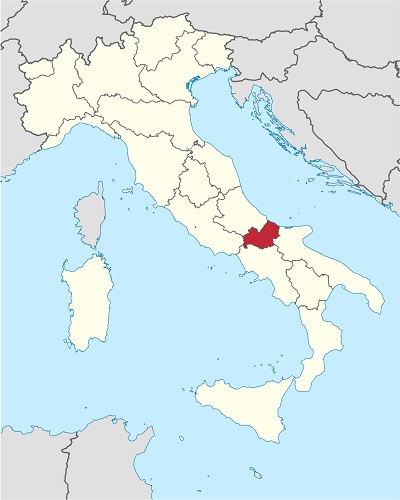Molise

Molise is located on the Adriatic coast. It is Italy’s second smallest region after Valle d’Aosta. The capital is Campobasso.
Despite its relatively small size and lower profile compared to other Italian wine regions, Molise has a long history of winemaking.
Molise Grapes
Molise produces a variety of grape varieties, both local, national and international. Important red grapes are Tintilia, Aglianico, Montepulciano, Sangiovese,and Cabernet Sauvignon. Important white grapes are Falanghina, Trebbiano, Bombino Bianco, Greco, Fiano and Malvasia.
One of the region's standout red grapes is Tintilia. Tintilia del Molise is a native grape that has gained recognition for its distinctive character. Mixed Red Berries and Black Fruit, where Cherries stand out, are typical Tintilia flavors. Dependent on aging, Tintilia wines can have a long and spicy aftertaste.
Molise DOC's
The Molise wine industry is primarily composed of small and medium-sized family-owned wineries, predominantly in hilly locations up to 600 meters above sea level.
While the region may not be as prominent on the wine scene as some other Italian regions, there is a growing interest in the unique wines produced in Molise, including reds, whites, and rosés. Good examples are:
Biferno DOC (1983)
White Wine: 70–80% Trebbiano Toscano + Other grapes from the DOC.
Red Wine: 70–80% Montepulciano, 10–20% Aglianico, and max 20% Other grapes.
Molise DOC (1998)
White Grapes: Chardonnay, Falanghina, Fiano, Greco, Malvasia, Moscato, Pinot Bianco, Pinot Grigio, Sauvignon Blanc, and Trebbiano.
Red Grapes: Aglianico, Cabernet Sauvignon, Merlot, Montepulciano, Pinot Nero, Sangiovese.
Pentro DOC (1983)
White Wine: Min 80% Falanghina, 15–20% Trebbiano Toscano, max 5% Other local grapes
Rosé Wine: 75–80% Montepulciano, 20–25% Tintilia, max 5% Other grapes
Red Wine: 75–80% Montepulciano, 20–25% Tintilia, max 5% Other grapes
Tintilla DOC (2011)
Red Wine: Min 95% Tintilia + Other grapes.
Rosé Wine: Min 95% Tintilia + Other grapes.
Wine Region Molise

Climate
Climate is influenced by the topography: A maritime climate in the coastal strip, a temperate climate in the uplands and a continental climate in the more inland and mountainous areas.
Soil
The soil varies from sandy and clayey in coastal areas to calcareous soils in the mountains.
Black Grapes |
White Grapes |

50% Montepulciano |

12% Trebbiano |
Red Wines |
White Wines |

|

|
Alcohol can be addictive. Always drink in moderation.
© Copyright 2015-2025 W3 Wine School. All Rights Reserved.
